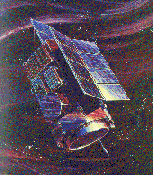|
|
The HEAO-1 Satellite

Beginning in 1977, NASA launched a series of
very large scientific payloads called High Energy Astronomy
Observatories (HEAO). The first of these missions, HEAO-1
surveyed the
X-ray sky almost three times over the 0.2 keV - 10 MeV energy band,
provided nearly constant monitoring of X-ray sources near the ecliptic poles.
More detailed studies of a number of objects were made through pointed
observations lasting typically 3-6 hours.
Mission Characteristics
 Lifetime : 12 August 1977 - 9 January 1979 Lifetime : 12 August 1977 - 9 January 1979
 Energy Range : 0.2 keV - 10 MeV Energy Range : 0.2 keV - 10 MeV
 Payload : Payload :
- A1 - Large Area Sky Survey experiment (LASS) :
0.25-25 keV, eff. area 7 modules each of 1350 - 1900 cm2,
FOV varied between 1° X 4° to 1° x 0.5° for finest collimators.
- A2 - Cosmic X-ray Experiment (CXE) :
six separate proportional counters
- Low Energy Detectors (LED) 0.15-3.0 keV, eff. area 2 detectors
of 400 cm2 each
- Medium Energy Detector (MED) 1.5-20 keV, eff. area 1 detector at
800 cm2
- High Energy Detector (HED) 2.5-60 keV, eff. area 3 detectors at
800 cm2 each
MED and HEDs had various FOV settings, 1.5° x 3°, 3° x
3° and 3° x 6°
- A3 - Modulation Collimator (MC) :
0.9-13.3 keV,
eff. area 2 collimators 400 cm2 (MC1) & 300 cm2 (MC2), FOV 4° X 4°
- A4 - Hard X-Ray / Low Energy Gamma Ray Experiment :
seven inorganic phoswich scintillator detectors
- Low Energy Detectors 15-200 keV, eff. area 2 detectors 100
cm2 each, FOV 1.7° x 20°
- Medium Energy Detectors 80 keV - 2 MeV, eff. area 4 detectors 45
cm2 each, FOV 17°
- High Energy Detector 120 keV - 10 MeV, eff. area 1 detector 100
cm2, FOV 37°
 Science Highlights:
Science Highlights:
- Complete flux-limited High Galactic Latitude Survey (Piccinotti
et al. 1982).
- Measurement of X-ray background from 3-50 keV (Marshall et al. 1980, ApJ, 235, 4.)
- Comprehensive catalog of X-ray sources (one for each experiment).
- Several hundred optical companions and source
classifications based on X-ray source positions.
- Monitored variability of a variety of objects from AGNs to X-ray
binaries.
- Studied aperiodic variability in Cyg X-1 on timescales on a
few milliseconds
- Discovered the first eclipse seen in a low-mass X-ray binary.
 Archive:
HEASARC hosts catalogs, spectra, lightcurves, maps and raw data.
Archive:
HEASARC hosts catalogs, spectra, lightcurves, maps and raw data.
Not all are available for all experiments.
[HEAO-1 Home]
[About HEAO-1]
[Archive]
[Software]
[Gallery]
[Publications]
[All Missions]
[by Time]
[by Energy]
Page authors: Lorella Angelini Jesse Allen
HEASARC Home |
Observatories |
Archive |
Calibration |
Software |
Tools |
Students/Teachers/Public
Last modified: Thursday, 24-Sep-2020 19:39:51 EDT
HEASARC Staff Scientist Position - Applications are now being accepted for a Staff Scientist with significant experience and interest in the technical aspects of astrophysics research, to work in the High Energy Astrophysics Science Archive Research Center (HEASARC) at NASA Goddard Space Flight Center (GSFC) in Greenbelt, MD. Refer to the AAS Job register for full details.
|


